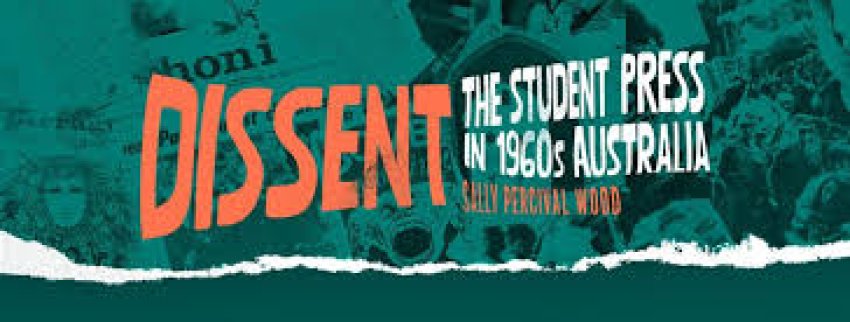
Dissent: The Student Press in 1960s Australia
Sally Percival Wood
Scribe, 2017
310 pages
Dissent didn’t obey strict decade-demarcation lines on Australian campuses in the radical 1960s, writes Sally Wood in Dissent: The Student Press in 1960s Australia.
In 1961, for example, university students were still mostly from a privileged background and a largely conservative lot. Wood, a historian from Deakin University, writes their attire was “jacket-and-tie and short-back-and-sides” for young men and “stiffly coiffured hair, twin-sets and skirts below the knee” for the women.
Their music tended to classical and jazz rather than rock ‘n’ roll. For politics, they placidly read rather anodyne student newspapers that mirrored rather than challenged the establishment press.
This non-threatening stasis was impolitely disturbed by the rapid government expansion of higher education to wider sections of the population to meet the needs of a modernising Australian economy.
The consequent infusion of new, working-class blood recharged the student body. The new student layers were much less deferential to the mystique of the ivory tower and more ready to challenge the social and political orthodoxies of the age.
Reflecting this, more subversive uni rags were at the forefront of this campus transformation.
Wood opens colourful time-capsules of the opinionated articles, heated editorials, energised letters and crazy cartoons from the revitalised student press. It covers censorship, sexual liberation, homosexuality, abortion, Aboriginal rights, the Cold War, anti-Stalinist socialism, poverty and housing, education reform and the environment.
The slaughter and lies of the Vietnam War, and conscription in particular — which took one-fifth of 20-year-old Australian men in a “Lottery of Death” — signalled the high-water-mark of student publishing dissent.
Some issues were slower to take flight. It wasn’t until 1971 that University of Adelaide’s On Dit “Bird of the Week” page became extinct as women students threw off their “Miss University” sashes and took control of their bodies.
One year later, purged by the Women’s Liberation Movement, On Dit became the only Australian student newspaper admitted as a member of the Underground Press Syndicate, a global alternative-media collective.
In ’60s Australia, each student newspaper issue was keenly awaited and savoured in depth. The uni rag could wield an influence beyond the campus, being seen as a “credible participant in shaping political discourse and challenging public policy”.
A decline of the student newspaper followed, however. Wood dates its demise from the election of a reforming Gough Whitlam Labor government in 1972, which marked not only a significant achievement of much of the student agenda but also quelled most of the ferment.
The retrenchment of dissent was accelerated by the market-based restructuring of higher education. The university increasingly became a business, vice-chancellors overpaid CEOs, education a commodity, students consumers and a degree purely an instrumental means to a vocational end.
The university culture, including the student newspaper, has been profoundly and negatively affected by this external economic context. But there have been some own goals, too, says Wood.
Her prime culprit is a post-Marxist “identity politics” where race, ethnicity, sex, gender and sexuality have sidelined a socialist class politics that had given a coherence and solidarity to the disparate struggles of the oppressed.
“The preponderance of stories about identity,” says Wood, would make the student newspaper of today “incomprehensible” to an earlier generation of baby-boomer undergraduates. While the economic and political foundations of capitalism are not only now met with more assent than dissent, gone too is “the university tradition of debate and the contest of ideas”.
Form has also deteriorated along with content, Wood says. The “bland magazine” format of the current crop of student newspapers with their emphasis on brevity and visuals rather than textual substance resembles an undisciplined blog in tone and structure.
The student newspaper has not only lost its capacity to épater le bourgeois (to shock and outrage respectable opinion) but also its ability, and desire, to dissect the bourgeoisie’s economic and political power.
Wood’s call to “reinvigorate the student magazines” of today with a healthy dose of ’60s passion and politics deserves to be answered.